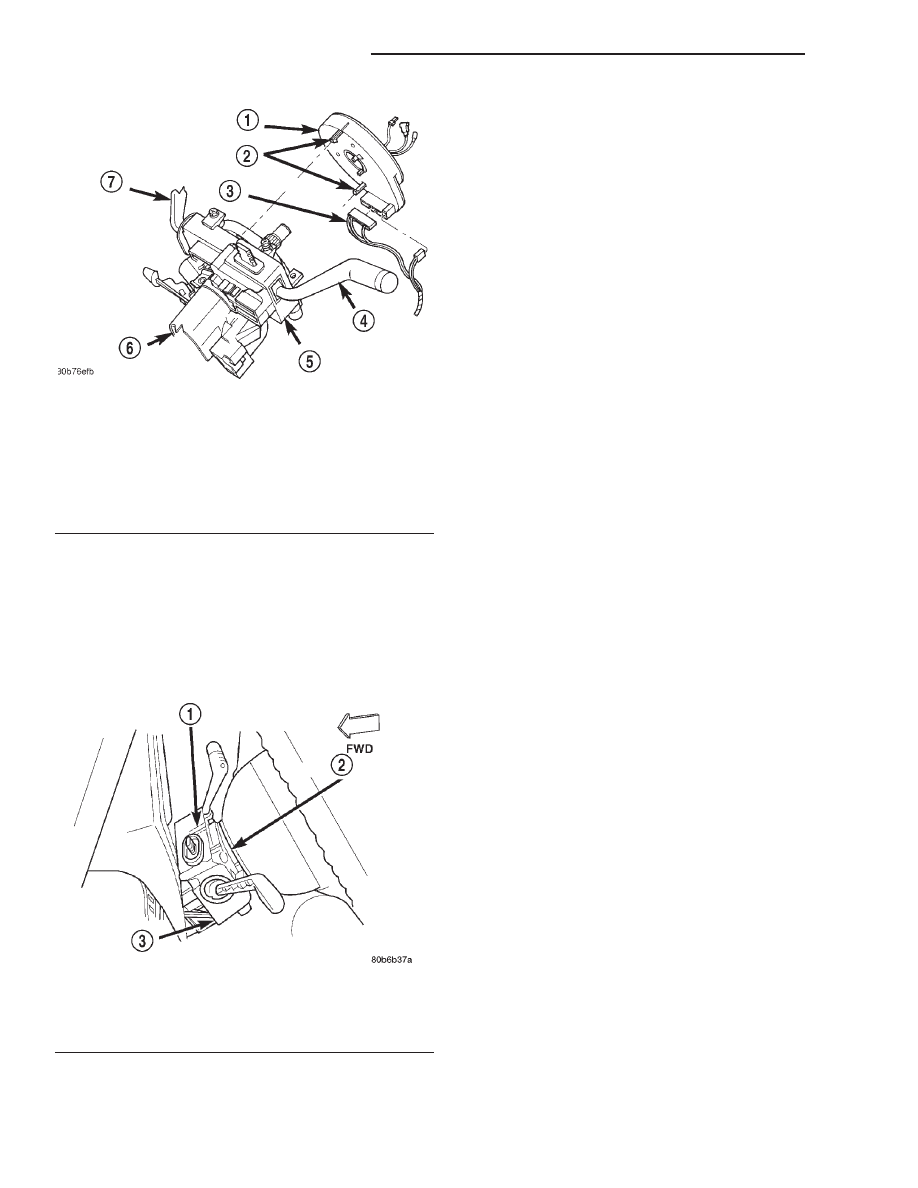Jeep XJ. Manual - part 131

clockspring latch with a small screwdriver (Fig. 15).
Gently pry both plastic latches of the clockspring
assembly to release them from the steering column
upper housing.
NOTE: If the clockspring plastic latches are broken,
be certain to remove the broken pieces from the
steering column upper housing.
(13) Remove the clockspring from the steering col-
umn. The clockspring cannot be repaired. It must be
replaced if faulty or damaged, or if the driver side
airbag has been deployed.
(14) If the removed clockspring is to be reused,
lock the clockspring rotor to the clockspring case to
maintain clockspring centering until it is reinstalled
on the steering column. This can be done by inserting
a stiff wire through the small index hole located at
about the 11 o’clock position in the centered clock-
spring rotor and case. Refer to Clockspring Center-
ing in the Adjustments section of this group for an
illustration of the clockspring index hole. Bend the
wire over after it has been inserted through the
index hole to prevent it from falling out.
INSTALLATION
If the clockspring is not properly centered in rela-
tion to the steering wheel, steering shaft and steer-
ing gear, it may be damaged. Refer to Clockspring
Centering in the Adjustments section of this group
before installing or reinstalling a clockspring.
Service replacement clocksprings are shipped pre-
centered and with a locking pin installed. This lock-
ing pin should not be removed until the clockspring
has been installed on the steering column. If the
locking pin is removed before the clockspring is
installed on a steering column, the clockspring cen-
tering procedure must be performed.
NOTE: Before starting this procedure, be certain
that the front wheels are still in the straight-ahead
position.
(1) If the removed clockspring is being reused,
remove the wire from the index hole that is locking
the clockspring rotor to the clockspring case to main-
tain clockspring centering.
(2) Be certain that the turn signal switch stalk is
in the neutral position, then carefully slide the cen-
tered clockspring down over the steering column
upper shaft until the clockspring latches engage the
steering column upper housing.
(3) If a new clockspring has been installed, remove
the locking pin that is securing the clockspring rotor
to the clockspring case and maintaining clockspring
centering.
(4) Reconnect the two instrument panel wire har-
ness connectors to the lower clockspring connector
receptacles. Be certain that the connector latches are
fully engaged.
(5) Position the steering column shrouds on the
steering column.
(6) Install and tighten the three screws that secure
the lower steering column shroud to the upper
shroud. Tighten the screws to 2 N·m (18 in. lbs.).
(7) Install the steering column opening cover onto
the instrument panel. Refer to Steering Column
Opening Cover in the Removal and Installation sec-
Fig. 14 Clockspring Remove/Install
1 – CLOCKSPRING
2 – LATCHES
3 – WIRE HARNESS
4 – TURN SIGNAL SWITCH LEVER
5 – WATER SHIELD BRACKET
6 – STEERING COLUMN
7 – WIPER SWITCH LEVER
Fig. 15 Upper Clockspring Latch Access Window
1 – UPPER CLOCKSPRING LATCH ACCESS WINDOW
2 – CLOCKSPRING
3 – WATER SHIELD AND BRACKET
8M - 14
PASSIVE RESTRAINT SYSTEMS
XJ
REMOVAL AND INSTALLATION (Continued)